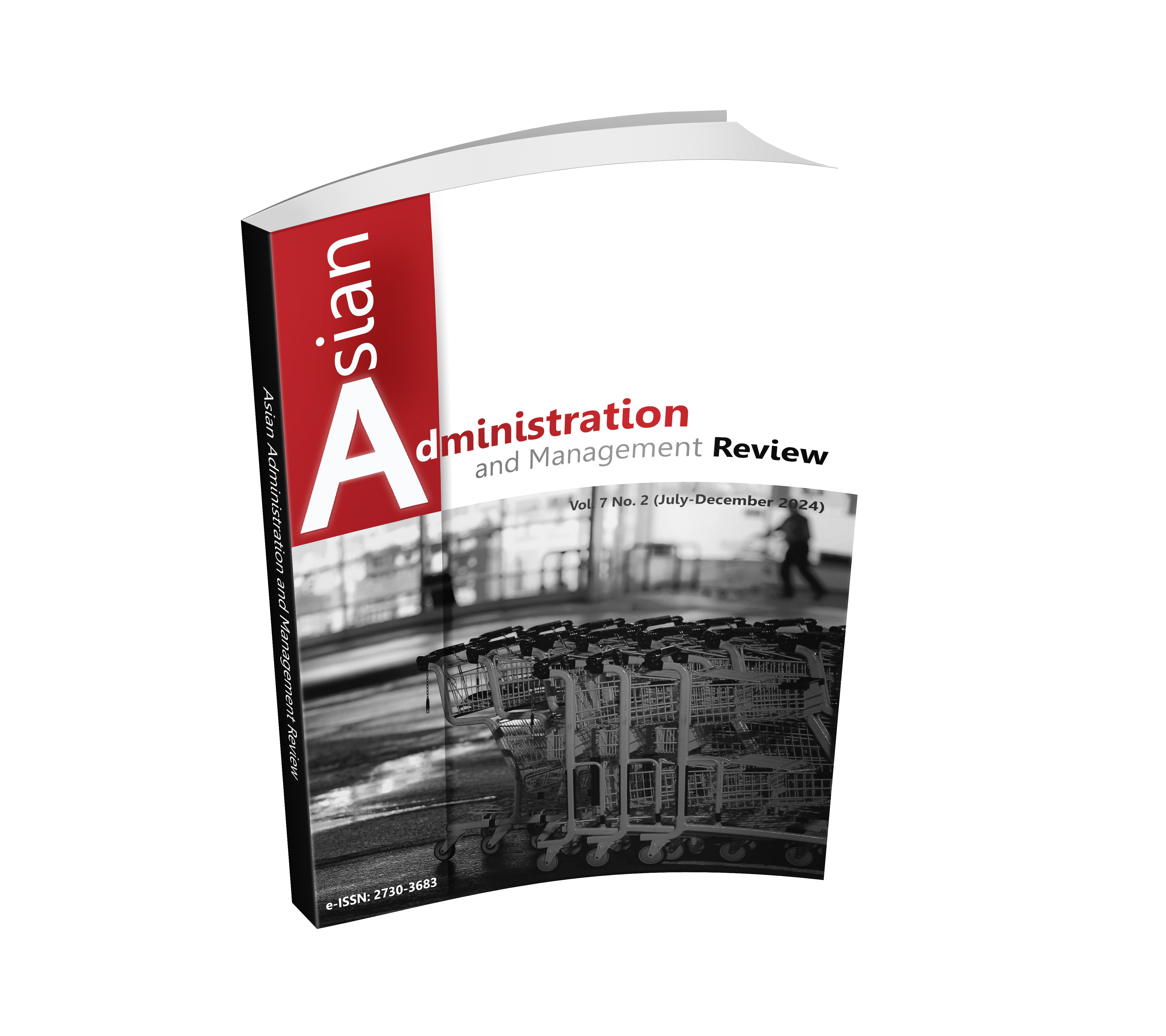ENHANCING OPERATIONAL EFFICIENCY: INVESTIGATING TECHNOLOGY READINESS, ACCEPTANCE, AND UTILIZATION OF THAILAND NATIONAL SINGLE WINDOW IN IMPORT, EXPORT, AND LOGISTICS BUSINESSES
DOI:
https://doi.org/10.14456/aamr.2024.18Keywords:
Technology Readiness, Acceptance and Use of Technology, Thailand National Single Window, Intention, Logistics BusinessesAbstract
The research aimed to identify factors encouraging direct use, which could improve industry efficiency in the digital era. The research methodology in this research was quantitative research with survey method by using questionnaires for data collection. The respondents were 400 import, export, and logistics entrepreneurs in the Bangkok Metropolitan Region who have previous experience in using Thailand National Single Window (NSW) system. The results of hypothesis testing revealed that technology readiness (optimism and innovativeness) and acceptance and use of technology (performance expectancy, effort expectancy, social influence, and facilitating conditions) affected intention to use the system. Acceptance and use of technology (performance expectancy, effort expectancy, social influence, and facilitating conditions) affected actual usage behavior whereas intention to use the system also affected actual usage behavior. Besides, technology readiness (optimism and innovativeness) affected actual usage behavior through intention to use the system at a statistical significance level of .001.
Downloads
References
Ajzen, I. (2002). Perceived behavioral control, self-efficacy, locus of control, and the theory of planned behavior. Journal of Applied Social Psychology, 32(4), 665-683.
Alhalafi, N., & Veeraraghavan, P. (2023). Exploring the challenges and issues in adopting cybersecurity in Saudi smart cities: Conceptualization of the cybersecurity-based UTAUT model. Smart Cities, 6(3), 1523-1544.
Bagozzi, R., & Yi, Y. (2012). Specification, evaluation, and interpretation of structural equation models. Journal of the Academy of Marketing Science, 40, 8-34.
Blut, M., & Wang, C. (2020). Technology readiness: a meta-analysis of conceptualizations of the construct and its impact on technology usage. Journal of the Academy of Marketing Science, 48, 649-669.
Brozzi, R., Riedl, M., & Matta, D. (2021). Key readiness indicators to assess the digital level of manufacturing SMEs. Procedia CIRP, 96, 201-206.
Chin, L., & Ahmad, Z. (2015). Consumers’ intention to use a single platform e-payment system: A study among Malaysian internet and mobile banking users. Journal of Internet Banking and Commerce, 20(1), 1-13.
Cochran, W. (1953). Sampling Techniques. New York: John Wiley & Sons, Inc.
Erdoğmuş, N., & Esen, M. (2011). An investigation of the effects of technology readiness on technology acceptance in e-HRM. Procedia-Social and Behavioral Sciences, 24, 487-495.
Fornell, C., & Larcker, D. (1981). Structural equation models with unobservable variables and measurement error: Algebra and statistics. Journal of Marketing Research, 18(3), 382-388.
Gaitán, J., Peral, B., & Jerónimo, M. (2015). Elderly and internet banking: An application of UTAUT2. Journal of Internet Banking and Commerce, 20(1), 1-23.
Hair Jr, J., Hult, G., Ringle, C., & Sarstedt, M. (2016). A primer on partial least squares structural equation modeling (PLS-SEM). California: Sage Publications.
Hair, J., Sarstedt, M., Ringle, C., & Mena, J. (2012). An assessment of the use of partial least squares structural equation modeling in marketing research. Journal of the Academy of Marketing Science, 40(3), 414-433.
Hooda, A., Gupta, P., Jeyaraj, A., Giannakis, M., & Dwivedi, Y. (2022). The effects of trust on behavioral intention and use behavior within e-government contexts. International Journal of Information Management, 67, 102553.
Hung, S., Chang, C., & Kuo, S. (2013). User acceptance of mobile e-government services: An empirical study. Government Information Quarterly, 30(1), 33-44.
Kampa, R. (2023). Combining technology readiness and acceptance model for investigating the acceptance of m-learning in higher education in India. Asian Association of Open Universities Journal, 18(2), 105-120.
Knekta, E., Runyon, C., & Eddy, S. (2019). One size doesn’t fit all: Using factor analysis to gather validity evidence when using surveys in your research. CBE—Life Sciences Education, 18(1), rm1.
Lai, Y., & Lee, J. (2020). Integration of technology readiness index (TRI) into the technology acceptance model (TAM) for explaining behavior in adoption of BIM. Asian Education Studies, 5(2), 10-17.
Luomala, R. (2016). The factors affecting the use of contactless payments. Master’s Thesis, Jyväskylä University School of Business and Economics.
Manutworakit, P., & Choocharukul, K. (2022). Factors influencing battery electric vehicle adoption in Thailand—Expanding the unified theory of acceptance and use of technology’s variables. Sustainability, 14(14), 8482.
Mohanarajan, A. (2016). Business as an art form. Master’s Thesis, Ontario College of Art and Design University.
Nugroho, M. (2015). Impact of government support and competitor pressure on the readiness of SMEs in Indonesia in adopting the information technology. Procedia Computer Science, 72, 102-111.
Nugroho, M., & Fajar, M. (2017). Effects of technology readiness towards acceptance of mandatory web-based attendance system. Procedia Computer Science, 124, 319-328.
Parasuraman, A. (2000). Technology Readiness Index (TRI): A multiple-item scale to measure readiness to embrace new technologies. Journal of Service Research, 2(4), 307-320.
Parasuraman, A., & Colby, C. (2015). An updated and streamlined technology readiness index: TRI 2.0. Journal of Service Research, 18(1), 59-74.
Phurkwattanakul, N., & Methavasaraphak, P. (2021). Factors Affecting the E-payment Adoption on E-commerce Platform System in Thailand. APHEIT International Journal, 10(2), 22-34.
Polit, D., & Beck, C. (2006). The content validity index: Are you sure you know what’s being reported? Critique and recommendations. Research in Nursing & Health, 29(5), 489-497.
Rahim, N., Humaidi, N., Aziz, S., & Zain, N. (2022). Moderating effect of technology readiness towards open and distance learning (ODL) technology acceptance during COVID-19 pandemic. Asian Journal of University Education, 18(2), 406-421.
Reyes-Mercado, P., Barajas-Portas, K., Kasuma, J., Almonacid-Duran, M., & Zamacona-Aboumrad, G. (2023). Adoption of digital learning environments during the COVID-19 pandemic: Merging technology readiness index and UTAUT model. Journal of International Education in Business, 16(1), 91-114.
Rinjany, D. (2020). Does technology readiness and acceptance induce more adoption of e-government? Applying the UTAUT and TRI on an Indonesian complaint-based application. Policy & Governance Review, 4(1), 68-86.
Savalei, V., & Bentler, P. (2005). A statistically justified pairwise ML method for incomplete nonnormal data: A comparison with direct ML and pairwise ADF. Structural Equation Modeling, 12(2), 183-214.
Tabachnick, B., Fidell, L., & Ullman, J. (2007). Using multivariate statistics. Massachusetts: Pearson.
Thailand National Single Window. (n.d.a). Policy. Retrieved from www.thainsw.net/INSW/Ent/DisplayPageServlet.
Thailand National Single Window. (n.d.b). NSW Operator. Retrieved from www.thainsw.net.
Venkatesh, V., Morris, M., Davis, G., & Davis, F. (2003). User acceptance of information technology: Toward a unified view. MIS Quarterly, 27(3), 425-478.
Wook, M., Yusof, Z., & Nazri, M. (2014). Data mining technology adoption in institutions of higher learning: A conceptual framework incorporating technology readiness index model and technology acceptance model 3. Journal of Applied Sciences, 14(18), 2129-2138.
Yuan, K., & Bentler, P. (2000). Three likelihood-based methods for mean and covariance structure analysis with nonnormal missing data. Sociological Methodology, 30(1), 165-200.

Downloads
Published
How to Cite
Issue
Section
License
Copyright (c) 2024 Authors

This work is licensed under a Creative Commons Attribution-NonCommercial-NoDerivatives 4.0 International License.











.png)


